The 2012 MacBook Air (11 & 13-inch) Review
by Anand Lal Shimpi on July 16, 2012 12:53 PM EST- Posted in
- Apple
- Mac
- MacBook Air
- Laptops
- Notebooks
Keyboard and Trackpad
The keyboard on the 2012 MacBook Air is the same as the 2011 model. You get a full sized keyboard on both the 11 and 13-inch models, with the alphanumeric keys measuring ~15 x 15mm. The function keys are half height on the 13 and even smaller on the 11, but there's no sacrifice in key size otherwise. Key travel and physical feedback are both as good as they can get on a chiclet-style keyboard. As Apple has now fully transitioned to this style of keyboard across all of its Macs, I can't really say I have any complaints about it. Apple's keyboard remains one of the best on the market.
The dedicated power button from the older Macs is gone and replaced with a power key that looks like another function key. The power key is functionally no different than the old power button - tap to turn on, hold to power down in the event of a hard lock.
The 2012 keyboard is nicely backlit, just like on every MacBook Air but the 2010. Apple offers fine grained controls over the keyboard backlight (16 adjustable levels). You can either choose to control it on your own or let the ambient light sensor control the intensity of the keyboard's backlight.
We spend so much time pointing out poor clickpads in the latest Ultrabooks that it's important to mention just how good the clickpad is in the MacBook Air. Apple continues to use the top hinged design on its glass covered clickpad. Clicks are easier towards the bottom of the pad than at the top where the hinge is. The clickpad is glass covered which makes it very smooth and comfortable to use. Finger rejection is handled extremely well under OS X, accidental clicks are very rare. I typically keep my thumb on the clickpad, near where the right mouse button would traditionally be, and mouse around with my index finger. While I normally have issues with this usage model on most of the clickpads I use, Apple's implementation is both the exception and the benchmark. It just works.
USB 3.0 Performance
USB 3.0 is alive and well on the new MacBook Air. Both ports support the standard and both OS X and the hardware supports the USB Attached SCSI Protocol (UASP). I have noticed that USB device compatibility is more finicky on the MacBook Air compared to the rMBP. Most devices seem to work fine but Kingston's HyperX Max 3.0 for example wouldn't work, although it worked fine on the rMBP. The hardware is actually detected by OS X, the drive simply never appears to Disk Utility or in Finder. A few folks have noticed something similar with other drives on Apple's support forums but the issue doesn't seem to have widespread implications.
USB 3.0 performance however is just as good as on the rMBP. I still need to grab a UASP enabled USB 3.0 device with 6Gbps SATA support to really stress the interface, but using Seagate's GoFlex USB 3.0 drive and a Kingston HyperX SSD in place of the mechanical drive I'm able to hit around 260MB/s:

Thunderbolt support comes courtesy of a 4-channel Cactus Ridge controller. The Thunderbolt port continues to be on the opposite side of the machine from the power connector. Anyone who owns a Cinema or Thunderbolt Display will bemoan the continued use of this configuration.
FaceTime HD Camera
Last year Apple introduced a 720p FaceTime HD camera to its MacBook Pro. The 2012 MBA inherits the same camera. Image quality remains acceptable as long as you're in a room with not terrible lighting.
Most of the Ultrabooks I play with these days try to mimic the FaceTime HD experience by using a 720p sensor. Arguably just as important as the sensor is the software that goes along with it. Photo Booth and Apple's FaceTime app are both extremely simple and quick to launch. I can't stress the importance of getting little details like this right when selling to general consumers.
SD Card Performance
The SD card reader on the 13-inch MacBook Pro had no compatibility issues with Patriot's EP Pro UHS-I SD card. Max performance of the reader appears to be capped at 40MB/s however:
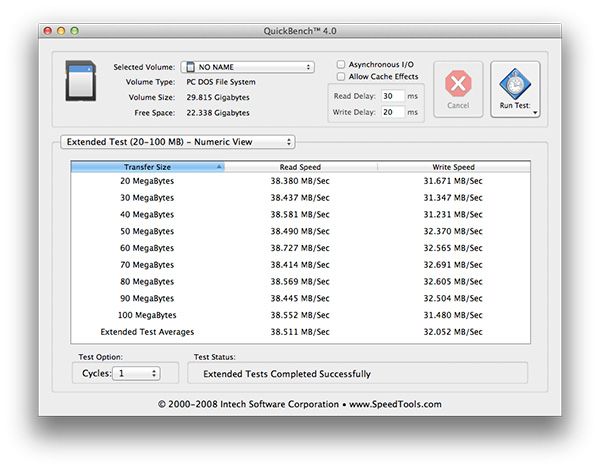
The rMBP by comparison can deliver more than 80MB/s in the read portion of this test. Even writes are faster at ~40MB/s on the rMBP compared to around 32MB/s here. It's a lot of these little things that contribute to the differences between Apple's MacBook Air and Pro lines.
WiFi Performance
Wireless connectivity remains unchanged from last year's model. Broadcom is on 802.11n WiFi duty with its BCM4322. Both 2.4GHz and 5GHz bands are supported. The same 2x2:2 configuration (2 send and receive antennas with 2 spatial streams) remains from last year as well.

I ran the 13-inch MacBook Air through the same three location WiFi test that I put the rMBP and 2011 MBP through, on both 5GHz and 2.4GHz. Performance on 2.4GHz was unusually low on the Netgear WNDR4500 I usually test with (10 - 20Mbps regardless of location) so I had to switch to the previous generation Apple Time Capsule to ensure there was nothing wrong with the notebook itself. All of the 2.4GHz MBA numbers have a star next to them to indicate that they aren't totally comparable as they're using a different AP. The 5GHz numbers all came from the Netgear however.
| Location 1 | Location 2 | Location 3 | |
| 2011 MacBook Pro (2.4GHz) | 124.0 Mbps | 12.6 Mbps | 61.6 Mbps |
| Retina MacBook Pro (2.4GHz) | 117.9 Mbps | 87.6 Mbps | 44.0 Mbps |
| 2012 MacBook Air (2.4GHz) | 95.7 Mbps* | 75.2 Mbps* | 31.2 Mbps* |
| 2011 MacBook Pro (5GHz) | 186.8 Mbps | 154.6 Mbps | 24.7 Mbps |
| Retina MacBook Pro (5GHz) | 227.7 Mbps | 156.8 Mbps | 33.7 Mbps |
| 2012 MacBook Air (5GHz) | 159.4 Mbps | 97.0 Mbps | - |
Overall WiFi performance is decent but obviously not as good as what you get from a MacBook Pro. Looking back at the results I almost wonder if the 2011 MBP wasn't showing some of these weird 2.4GHz issues on the Netgear router as well.
In the best conditions on 5GHz you can hit around 160Mbps, but you pretty much have to be right next to a good AP for that to work. Across a large room or in an adjacent one just under 100Mbps is possible on 5GHz as well. Go further out and you'll have to switch over to 2.4GHz.
There are no wired network options by default, however Apple's Thunderbolt to Gigabit Ethernet adapter works just fine on the new Air as well as the rMBP.
MagSafe 2
MagSafe 2 makes an appearance on the new MacBook Air, although it's curiously absent from the non-retina MacBook Pro. Eventually I'd expect all Macs to use MagSafe 2. The current state of things is likely temporary fragmentation. Similar to the rMBP, the actual power adapters themselves haven't changed: 45W is all you need for both systems.
Ivy Bridge on Air
Apple keeps its CPU options pretty simple and straightforward. You get a choice of three different CPUs, all dual-core, all rated at a 17W TDP. The Core i5-3317U comes standard in the 11, the i5-3427U comes with the 13, and both systems can be upgraded to the Core i7-3667U.
The breakdown between the chips is below:
| Apple 2012 MacBook Air Comparison | |||||
| 1.7GHz dual-core | 1.8GHz dual-core | 2.0GHz dual-core | |||
| Standard On | 11-inch MBA | 13-inch MBA | Optional for Both | ||
| Intel Model | Core i5-3317U | Core i5-3427U | Core i7-3667U | ||
| Base Clock Speed | 1.7GHz | 1.8GHz | 2.0GHz | ||
| Max SC Turbo | 2.6GHz | 2.8GHz | 3.2GHz | ||
| Max DC Turbo | 2.4GHz | 2.6GHz | 3.0GHz | ||
| L3 Cache | 3MB | 3MB | 4MB | ||
| AES-NI | Yes | Yes | Yes | ||
| VT-x | Yes | Yes | Yes | ||
| VT-d | Yes | Yes | Yes | ||
| TDP | 17W | 17W | 17W | ||
| Processor Graphics | Intel HD 4000 | Intel HD 4000 | Intel HD 4000 | ||
| GPU Clock (Base/Max) | 350/1050MHz | 350/1150MHz | 350/1150MHz | ||
The Core i7 upgrade is likely worth it if this is going to be your primary system for an extended period of time, particularly if it's acting as a desktop replacement. As a mobile device the standard CPUs are quite fast. If you're an annual upgrader, save your money, but if you're going to hold onto the system for a while and do a lot of heavy work on it, the upgraded CPU is probably worth it.
There is a known bug with the upgraded CPU under Windows today. Turbo Boost is disabled under Windows on the 3667U, although it's fully functional under OS X. Apple is aware of the problem and I'd expect a fix at some point, but there's no indication of when.


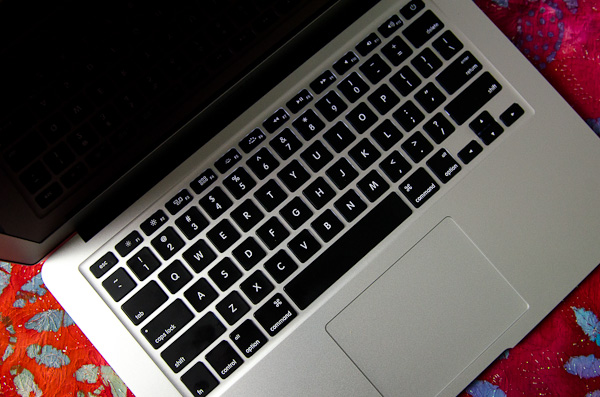
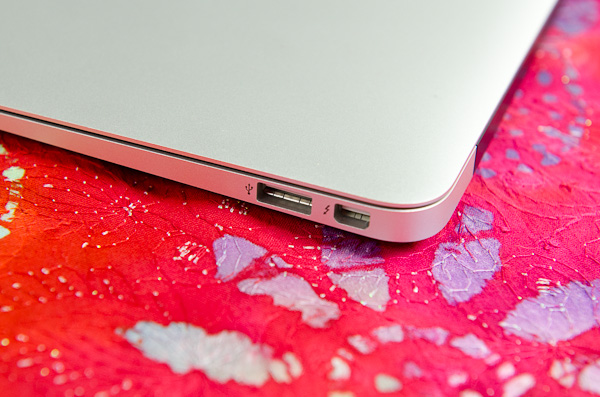

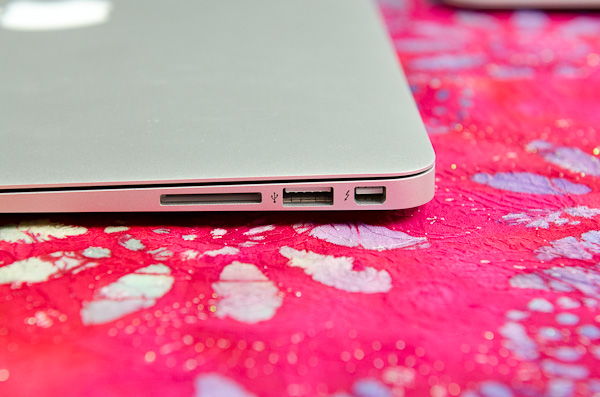
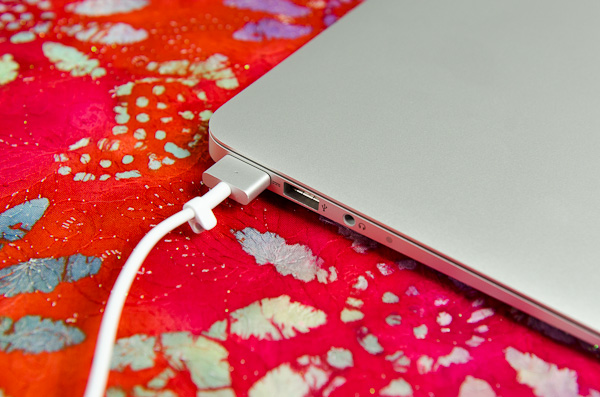








190 Comments
View All Comments
MrJim - Tuesday, July 17, 2012 - link
Thanks for the reply sir!I would like "ultra small form factor removable DRAM standards" and i think many of us would. But it also seems for me that this is part of a corporate strategy, car makers have done this for years. "You can only buy stuff from us, good quality we promise, and of course alot more expensive than some of the other 200 makers of that perticulur car engine part".
To say the least for changing batteries. And i did expect you to sit on information that we ordinary people doesnt have. Im looking forward to the future, but i like choice thats all.
Karltheghost - Tuesday, July 17, 2012 - link
Sure you're right. If i buy a Notebook, it is less serviceable than a full size desktop PC. And if i buy an Ultrabook it is even less serviceable. But being able to change the only wearing part in an expensive part of Elecronics, that is not likely to last as long as the rest of the Laptop is the least i want to do. By the way it's the same for Smartphones. I just don't want to buy a product which i need to replace completely if the battery wears out because i cannot change it myself and having it replaced is nearly as expensive as a new Laptop/Smartphone. And because there are manufactors who sell Smartphones and Ultrabooks with changeable batteries, your argument, as far as it goes to batteries, is not very convincing. As for other parts you're right, demanding switchable CPUs or something like that in an Ultrabook would be hilarious.KPOM - Tuesday, July 17, 2012 - link
There are more and more Ultrabooks sold with non removable batteries now. The Samsung Series 9 is one example.Tegeril - Monday, July 16, 2012 - link
"Very disappointed Anand. Very disappointed with you."Hilarious.
The MBA is still a class leading entry in the ultraportable market. It no longer wins in every single category (see: display), but that does not mean it is not a great system.
You ignore things like consumer SSDs being consumer SSDs in large packages without custom manufacturing. Apple's memory upgrades have always been more expensive than retail and have actually come closer to reality recently. But again, this is not a stick of mass produced memory, it's not an apples to apples comparison. As far as overcharging in any other area of the system, you fail to accurately include chassis, trackpad, magsafe, and other superior elements that can't be compared in the way you want to do spec to spec comparisons.
Being melodramatic about this review is what's disappointing. It very accurately describes why Apple is selling these and their pro systems so much more successfully than in the past. They're very good systems.
KoolAidMan1 - Monday, July 16, 2012 - link
The Apple haters are out in force, as usual.So mad.
Karltheghost - Tuesday, July 17, 2012 - link
So everyone who criticises Apple is automatically a hater? Seems like you're as differenciating as the haters . . . In fact, there are plenty of people out there who had an apple product and are therefore not very fond of apple. For example i bought an Ipod because i wanted a good Mp3-player. It did everything except from playing Mp3s in a proper way and i wasn't the only one who had this issue (Referring to an Ipod nano 3g, the bad sound without equalizer and the scratching noises with equalizer turned on).And i know a lot of people who sold their Macbook Pros 2 weeks after purchasing and bought regular windows machines because there are flaws that the technical specs don't reveal . . .
KPOM - Tuesday, July 17, 2012 - link
"Macs are garbage and I should know because I bought an iPod once and it didn't work right, plus my friend returned a MacBook Pro 2 weeks after buying it." These are anecdotes.It's OK to criticize Apple. Heck, the original MacBook Air got a lot of criticism from hard core Mac fans when it first came out. However, few company's products inspire the fierce criticism that anything Apple puts out does.
I get the sense that if Apple stuck its logo on hardware completely identical to an ASUS Zenbook or Samsung Series 9, there would be 6 pages of comments on this site from many of the Apple bashers criticizing every little flaw, but when the actual product reviews come out those same people won't be posting anything but praise for the product.
Karltheghost - Tuesday, July 17, 2012 - link
Of course that are anecdotes, hence i wrote "For example" at the beginning . . .But actually i rely more on my personal experience and that of others, by whom i know what they're doing with their stuff than on some fanboyspeech (this is not intendet as criticism for this review). What i can say is that i made bad experiences with apple and friends too and there are much more bad experiences than good ones. So i am very sceptical. On the other hand i had very bad experiences with other brands too (e.g. i had 2 HP Notebooks that lastet less than 3 months), but there are plenty of others who hadn't problems for years. So what i'm referring to is kind of a good/bad-balance . . .
It's not that i wouldn't buy a product just because it has an apple on it. In fact i would buy one if it fulfills my needs. But as long they're charging premium prices for machines that you can literarily throw away as soon the warranty runs out and have horrible software restrictions i'll stick with the bulky, ugly things that other manufactures are producing
KPOM - Tuesday, July 17, 2012 - link
What makes an Apple a throwaway product after a year? It still functions. My sister has a 2006 MacBook that is in almost new condition (though she hasn't used it much since getting a 2011 MacBook Air).Also, there are no software restrictions on OS X. Even with Mountain Lion, you can purchase and install your own software. This isn't iOS or Windows RT, where you must purchase from an App Store. The Mac App Store is optional.
Sure, it won't run Windows as good as a PC with the same specs will, but it will run pretty well. I think what most Mac users who run Windows find is that over time, they use Windows less and less, perhaps just for that old program that just doesn't have a Mac equivalent. Heck, even Windows 7 includes an "XP Mode" to run XP in virtualization, so it isn't unique to the Mac. I can quibble a lot about how Microsoft has "crippled" support for 16-bit apps, or how the 64-bit version dropped support for some old peripheral that worked just fine in XP.
Karltheghost - Tuesday, July 17, 2012 - link
Just personal experience. After 2 Years or so most products get faulty, even if it's just the battery or a fan. On most Apple products you can't change that yourself as it's tightly integrated in the system and for example, a friend of mine payed 170€ just for a new iphone battery . Thats a financial write-of.With software restrictions i was referring to the windows/linux thing. The only reason windows runs slow is that apple provides bad drivers so you stick with osx.
A bunch of horses won't get me to use OSX, i tried it once and it felt like a cage where the restrictions are covered by a lot bling-bling animation. While there are some nice things about it, like the touchpad integration you have even less system access than under windows. Nothing to convince a linux user and also nothing to replace windows on the gaming machine ;)
The license agreement does the rest (yeah, i actually read that thing)